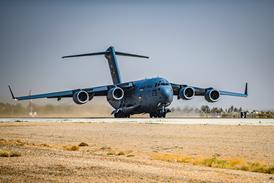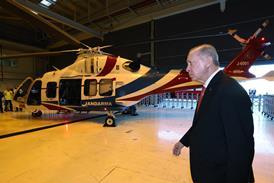AgustaWestland – like every Finmeccanica company – is a bit sensitive right now. Interviews with the company are granted only on the basis that quotes are attributed to the organisation rather than individuals. The stricture, driven by the changes at the top of Finmeccanica and part of the spring cleaning initiated by new chief executive Mauro Moretti, has particular resonance for AgustaWestland. His appointment can be traced directly to the abrupt departure in February 2013 of Guiseppe Orsi as part of huge fallout from a scandal involving the sale of helicopters to the Indian government. It is an issue that has hung over the helicopter manufacturer for the past year or more, overshadowing any achievements. In fact, to illustrate the lasting legacy of the India deal, one only has to type "AgustaWestland" into the search bar of Google to bring up the suggestion "AgustaWestland India". It is, as the company describes it, "such a touchy subject".
But to put that issue aside for a moment – and it is worth adding that an Italian court recently cleared AgustaWestland of any wrongdoing in the India case – there have been things to crow about over the past 12 months. Top of the list is the certification and first delivery earlier this year of its newest helicopter, the 8.3t AW189 – at the time of writing the only one of the new breed of super-medium rotorcraft to enter service. Those milestones were followed in July by military certification for the AW149 – the defence variant of the AW189. Although the airframer is yet to achieve sales success with the AW149, the parallel development of the two helicopters underscores AgustaWestland’s philosophy of versatility when embarking on new programmes – essentially making them easily adaptable to both civil and military markets, something that is particularly vital as defence spending shrinks. "The solution for slender budgets is to make good use of the capability we have," it says.
That philosophy was first demonstrated on the civil AW139 intermediate twin, which aside from robust sales in offshore and utility transport guises has comfortably made the leap to the military in the form of the AW139M. The Italian air force, for example, uses the platform for search and rescue missions, where it has replaced the elderly Agusta HH-3F Pelican fleet.
It believes that a twin-track approach means that ultimately a customer receives a cheaper helicopter because it is not a bespoke, niche product whose development costs cannot be quickly amortised. Comparatively, militarisation of an existing platform is relatively inexpensive. That’s not to say AgustaWestland cannot or will not offer those specialised aircraft as well, and it remains committed to the dedicated military helicopters in its range, such as the AW159, AW101, NH90 and T129A, albeit the latter two are effectively joint ventures with Airbus Helicopters and Turkish Aerospace Industries, respectively. However, the AW101 – AgustaWestland’s 15.6t heavy transport and anti-submarine warfare rotorcraft – may still join its smaller siblings in the civil market. News surfaced this time last year that the airframer was considering the potential civil certification of the AW101. AgustaWestland confirms that this is still a potential avenue for exploration, although that it will wait for customer commitment before embarking on the regulatory push.
"There is some interest coming from long-range [offshore] operators,” it says. “We are looking at this opportunity, but clearly we need to have a good business case for that. The aircraft has unique capabilities, however."
Dialogue is under way with potential customers, it says, and it hopes for a positive decision over the next year or two for service entry by the end of the decade. That said, it says that the AW101 still has enough "momentum" in the military market for a sustained future, despite production not being "what it was in the early years". But it adds: "The more we diversify the product, the easier it is to manage production through peaks and troughs."
And meantime, the production line is kept busy with a number of modification contracts, for example, marinising former UK Royal Air Force Merlin HC3s to the HC4 standard for use by the Royal Navy. “The transformation of existing assets is part of our strategic view moving forward,” the company says. "We increasingly specialise in making the best use of the life of the assets, modifying them for longer service.
"For the military, we are making the best out of leaner times. Adaptability and flexibility have always been characteristics of our company – we have always been nimble. Since we [Agusta and Westland] came together, we have had diversity as our offering."
That point distinguishes it from its US-based rivals, it argues, which typically get at least 55-60% of their revenues from the US Department of Defense. "They are dominated by a single customer,” it says.
The DoD is something of a sore topic at present, given that AgustaWestland has sued to prevent the US Army from buying up to 155 Airbus Helicopters UH-72A Lakotas for use as trainers without an open competition. "There are solutions offering better value for money out there," the company says. However, the DoD has a habit of getting what it wants, even when running a supposedly open competition. Witness, for instance, the outcomes of the contests for the US Air Force's new combat search and rescue platform and the navy's new presidential helicopter. In both cases, Sikorsky emerged as the winner after the requirements were so tightly defined that no other prime contractor could see a way of bidding successfully. However, the company argues that in the case of the Lakotas there are "many off-the-shelf solutions", whereas the presidential helicopter is incredibly specialised: "One is a limousine and the other is a small car for doing the school run in."
The "next baby" due to arrive, however, is the 4.5t AW169 medium twin. Certification is due in the next few months, with deliveries to start in 2015. The clean-sheet helicopter will be the first "to offer something new in a segment that's not seen anything new in 30 years", the company says.
It is a part of the market undeniably dominated by its French rival, whose EC145 and, to a lesser extent, AS365 will be the AW169’s main competitors.
Around 100h of flight testing remain to be completed on the AW169, with the programme having so far accumulated over 1,000h across four prototype craft. The initial handovers of the Pratt & Whitney Canada PW210A-powered helicopters will be to European clients, says AgustaWestland, due to the proximity of spare parts and technical assistance should teething troubles arise.
It plans to deliver around 15 machines next year, with that number doubling the year after. The majority of production will initially be at its factory in Vergiate, Italy. The company’s plant in the US city of Philadelphia is due to come on stream in mid-2015 and to hand over its first helicopter in early 2016.
Some 120 purchase agreements for the AW169 have been taken by the airframer, and it forecasts around 1,000 sales over the next 20 years.
Although AgustaWestland primarily bills the machine as a utility or emergency-medical-services platform, it says it sees great potential to sell the new rotorcraft into the VIP segment, where operators want to trade up from the light-twin AW109. "It's a little bit like the automotive sector, where you always look for something bigger. If you are lucky enough to afford a helicopter, you will follow an upgrade path,” it says.
Further down the weight range, the only new product envisaged at the moment is the AW109 Trekker variant, which has skids added and is largely aimed at to the US EMS market.
However, plans to join forces with Russian Helicopters to jointly develop and produce a new light single are now officially at an end. AgustaWestland has been coy about the reasons for this, despite its partner signalling that the project was at an end back in June. However, it says: “We both decided that the aircraft which was coming off the drawing board was probably not the right design in terms of the economics and what we were able to offer in the marketplace.”
In a volume market, "you need to be very careful on the production costs", the company says, noting that for an aircraft to be produced successfully in collaboration "it must cost less than [if you had] done it on your own".
Although AgustaWestland is continuing to develop its AW609 civil tiltrotor – certification is still expected in 2017 – its research and technology department is also looking to the next generation of aircraft. As part of the EU-funded Clean Sky 2 green aviation initiative, the airframer is working on what it is calling, somewhat predictably, the NextGen CTR. The EU-funded portion of the project runs until 2024, and the company is expecting a first flight around 2020. It is presently seeking partners for the programme and hopes to conclude this process by 2015-16. A clean-sheet design that will seat up to 25 passengers – the AW609 accommodates nine – it moves the engines significantly inboard, and only the rotors tilt, rather than the entire powerplant and nacelle. AgustaWestland is confident that the concept can be scaled up to carry as many as 50 passengers, making it a more versatile turboprop transport aircraft thanks to its vertical take-off and landing capability. Production is envisaged to begin in 2025, by which point the AW609 will already be 10 years old. As AgustaWestland notes: “You always have to think ahead. In aerospace, everything takes such a long time.”
Source: Flight International























